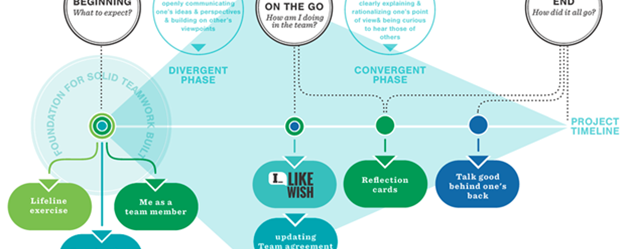Design of hybrid flexible teaching
In 2020, after the breakout of Covid-19, there was a need in many Universities worldwide for a quick transition from onsite to online teaching and learning. Online methodologies and technology were re-evaluated, and the terms ‘blended’, ‘online’ and ‘hybrid’ were loved and hated.
The term ‘hybrid’ re-emerged during the pandemic with many connotations. Not only is it used as synonym for blended learning, but generally it is seen as a model of teaching where students may attend to sessions on-campus or online. Teaching takes place in both at the same time.
Whereas the hybrid teaching model is mostly synchronous the hybrid flexible model adds an asynchronous aspect so that learning can take place outside preset class sessions. The “HyFlex” model was developed at San Francisco State University (2006) [1] in response to the large number of students who commuted or had to balance full-time work with their studies. Since then it has been adopted at institutions around the world.
Research suggests that the opportunities provided by hybrid models are promising for improving educational outcomes. It can be especially beneficial to students with special needs. Milman et co. presented a scenario where severe and irregular migraines caused a difficulty to attend regular class sessions [2]. The HyFlex teaching model offered a way to participate online asynchronously.

360 visual of Aalto Hybrid teaching studio
What to consider when planning for hybrid flexible teaching:
1) What are my expectations and what are the students’ expectations? Do they overlap well enough? I should explain the course structure as well as possible. I could even create a visual tool such as a chart or a timeline to help the students (and myself) navigate the course.
2) Since I’m using online tools I should determine which part of the course would consist of synchronous face-to-face learning (online or on-site) and which could include self-paced activities such as videos, quizzes (with automatic grading) and asynchronous group discussion or writing/creating content. My aim is to find a balance and create a sense of togetherness among all students.
3) I should hear feedback and be ready to redesign the content or implementation accordingly. Can I see the strengths and accommodate for weakness? Critiquing anonymously online is easy – I will gather and build from feedback but be gentle to myself.
4) I need to be careful not to create too much work; the new setup will take more time. I could talk to others and ask for help from Aalto services.
Author: Silvana Pérez Läherinta
[1] Hybrid Flexible (Hyflex) Teaching and Learning. University of San Francisco. Retrieved 7 Feb 2020. https://myusf.usfca.edu/ets/id-hyflex.
[2] Milman N., Irvine Kevin V., Miller K., Saichaie K. 7 Things You Should Know About the HyFlex Course Model. EDUCAUSE Learning Initiative (ELI) Collection(s): ELI 7. Retrieved 7 Feb 2020. https://library.educause.edu/-/media/files/library/2020/7/eli7173.pdf
